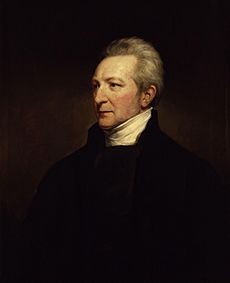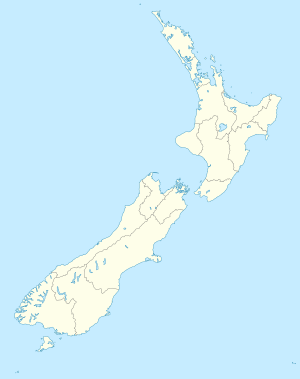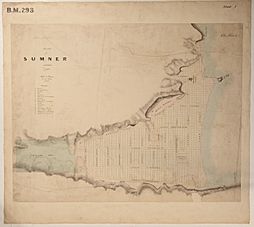Sumner, New Zealand facts for kids
Quick facts for kids
Sumner
|
|
|---|---|
|
Suburb
|
|

Looking down on Sumner (left) from Scarborough
|
|
| Country | New Zealand |
| Local authority | Christchurch |
| Electoral ward | Heathcote |
| Area | |
| • Land | 264 ha (652 acre) |
| Population
(June 2022)
|
|
| • Total | 3,570 |
| Clifton | (Pegasus Bay) | |
| Richmond Hill |
|
Scarborough |
| Port Hills | Te Onepoto / Taylors Mistake |
Sumner is a coastal seaside suburb of Christchurch, New Zealand and was surveyed and named in 1849 in honour of John Bird Sumner, the then newly appointed Archbishop of Canterbury and president of the Canterbury Association. Originally a separate borough, it was amalgamated with the city of Christchurch as communications improved and the economies of scale made small town boroughs uneconomic to operate.
Contents
History

Sumner was surveyed in 1849 by Edward Jollie for Captain Joseph Thomas, the advanced agent of the Canterbury Association. His map showed 527 sections and numerous reserved and provisions for churches, schools, cemeteries, town hall, emigration barracks and other town amenities. However, his plans were abandoned through lack of funds and a new survey on which Sumner is based was carried out in 1860.
Captain Thomas named the settlement for Bishop John Bird Sumner, one of the leading members of the Canterbury Association. The Māori name for the area is Ohikaparuparu ("o" means place of; "hika" means rubbing, kindling, or planting; "paruparu" means dirt, deeply laden, or a preparation of fermented cockles).
Sumner was at first under the control of the Canterbury Provincial Council. In 1872, it came under the control of the Heathcote Road District. When provincial councils were disestablished in 1876 and replaced with counties, Sumner had a second parent body, the Selwyn County added to the continuing road board. In 1883, Sumner was constituted as a town district and was run by a board of five elected commissioners. The board elected its own chairmen, and the two people who filled that role were C. L. Wiggins (March 1883 – September 1884) and J. M. Wheeler (September 1884 – June 1891). On 1 June 1891, Sumner was proclaimed a borough. Mayoral elections were held on 27 June, and the last chairman was elected the first Mayor of Sumner.
The first European to carry out work in Sumner is believed to be Charles Crawford, a whaleboat owner, who transported materials from Port Cooper, now Lyttelton, under contract to build the headquarters and storeroom for Captain Thomas. Sumner was settled in late 1849 or early 1850 by work crews building the road to Lyttelton, Sumner is thus one of the oldest European settlements in the Christchurch area. The Day family was the first to settle permanently in Sumner followed by Edward Dobson and his family. Sumner had its first shop early in 1870, and its proprietor, S.E. Horneman, was postmaster from 1873 until 1876.
In 1885 the Harbour Board granted the concession to build a bath at the East end of Sumner beach. S.L. Bell enclosed some of the sea, built dressing sheds and a tea shop. The bathing pool was a great attraction but every year terrific storms would batter the bath and gradually dump fine sand. Eventually a flood filled the bath with clay and silt from the hills causing its closure.
In 1912 Sumner established its own gasworks and electricity was connected in 1918. The Anglican evangelical leader William Orange was vicar of Sumner from 1930–1945.
On 22 February 2011, Sumner was hit by the Christchurch earthquake, which destroyed or made uninhabitable a large number of the local houses and commercial buildings. On 13 June the same year, Sumner was hit by another earthquake of almost the same magnitude as the February event. These two earthquakes caused many of Sumner's iconic cliffs to collapse, and many areas to be cordoned off with both traditional fences and shipping containers.
Geography
Sumner is nestled in a coastal valley separated from the adjacent city suburbs by rugged volcanic hill ridges that end in cliffs that descend to the sea shore in places. Sumner Bay is the first bay on the northern side of Banks Peninsula and faces Pegasus Bay and the Pacific Ocean.
Because of its ocean exposure, a high surf can form in some swell conditions. The beach is gently sloping, with fine grey sand. It is a popular surf beach for these reasons.
Sand dunes have filled the river valley behind the beach. This has made housing construction relatively easy, although flooding at the head of the valley has been a problem in the past due to the reverse slope caused by the sand dunes filling the front of the valley. This has been addressed by a flood drain.
The rocky volcanic outcrop of Cave Rock dominates the beach. Until the mid-1860s, the feature was known as Cass Rock, after the surveyor Thomas Cass. There are other rocky outcrops in the area and the volcanic nature of the geology is readily apparent from several of the exposed cliffs around the valley.
A sea wall and wide esplanade have been built along the length of the beach to prevent coastal erosion.
Sumner bar
The outlet of the Avon Heathcote Estuary at the western end of the beach, near another large volcanic outcrop known as Shag Rock, or Rapanui, forms the Sumner bar off shore of Cave Rock. The Sumner bar presents a major hazard to shipping, while the fast currents, strong rips and undertows in the area can be a danger to swimmers.
The Sumner Bar is a sand bar where the estuary meets the sea and is notoriously dangerous to cross. One regular vessel crossing the bar in the early days was the Mullogh, New Zealand’s first iron hulled steamer. On 25 August 1865 the Mullogh ran onto Cave Rock, Sumner, in violent surf. Her cargo of liquor created keen interest on the beach. George Holmes of Pigeon Bay, the contractor for the Lyttelton Rail Tunnel, then bought the ship, refitted and used her until 1869.
The NZ Trawler Muriel was stranded on Sumner Beach in 1937 and was a total loss and had to be dismantled where she lay.
Sumner Life Boat Institution
Because of the hazard posed by the Sumner Bar, Sumner has had a lifeboat of some kind almost since its settlement. There is no record of a formal or even informal lifeboat being available prior to the appointment of a pilot in September 1864. However, it is likely that small open rowing boats were available in the bay from the early 1850s.
The Sumner Life Boat Institution has operated a formal life boat or similar rescue craft in the bay since 1898. The traditional name of Rescue has been applied to many of the life boats.
Demographics
The statistical area of Sumner, which includes Scarborough and Te Onepoto / Taylors Mistake, covers 2.64 km2 (1.02 sq mi). It had an estimated population of 3,570 as of June 2022, with a population density of 1352 people per km2.
| Historical population | ||
|---|---|---|
| Year | Pop. | ±% p.a. |
| 2006 | 3,768 | — |
| 2013 | 3,483 | −1.12% |
| 2018 | 3,519 | +0.21% |
Sumner had a population of 3,519 at the 2018 New Zealand census, an increase of 36 people (1.0%) since the 2013 census, and a decrease of 249 people (-6.6%) since the 2006 census. There were 1,338 households. There were 1,752 males and 1,764 females, giving a sex ratio of 0.99 males per female. The median age was 42.6 years (compared with 37.4 years nationally), with 714 people (20.3%) aged under 15 years, 483 (13.7%) aged 15 to 29, 1,806 (51.3%) aged 30 to 64, and 516 (14.7%) aged 65 or older.
Ethnicities were 95.6% European/Pākehā, 4.9% Māori, 0.6% Pacific peoples, 2.1% Asian, and 2.5% other ethnicities (totals add to more than 100% since people could identify with multiple ethnicities).
The proportion of people born overseas was 29.5%, compared with 27.1% nationally.
Although some people objected to giving their religion, 57.6% had no religion, 33.5% were Christian, 0.2% were Hindu, 0.5% were Buddhist and 1.9% had other religions.
Of those at least 15 years old, 1,113 (39.7%) people had a bachelor or higher degree, and 216 (7.7%) people had no formal qualifications. The median income was $43,600, compared with $31,800 nationally. The employment status of those at least 15 was that 1,419 (50.6%) people were employed full-time, 501 (17.9%) were part-time, and 66 (2.4%) were unemployed.
Education
Sumner School
Sumner School was founded in 1876 and is these days a full primary school, teaching children from years 1 to 8. The school has a roll of 342 students as of February 2024.
Our Lady Star of the Sea School
Our Lady Star of the Sea Catholic School is a full primary school, teaching children from years 1 to 8. The school has a roll of 80 students. It opened in 1928.
Ko Taku Reo
The former van Asch College, which took hearing-impaired children from all over the South Island and the southern North Island, is now a residential campus for Ko Taku Reo. It opened in 1880 as Sumner School for the Deaf.
Sumner College
Variously known as "Sumner College", "Beach Glen Boarding School" or "Chelford", existed in Sumner between about 1877 and 1895. Schoolmaster C. L. Wiggins, as he was almost invariably known, appears to have moved his boarding school for young gentlemen to Sumner in August 1877, according to newspaper advertisements of the time. Wiggins has previously operated his boarding school at Akaroa and Fernside, before moving to Sumner. The school taught "the usual branches of a sound English education, together with Latin and French" and provided recreations including sea bathing, cricket, and "pedestrian excursions". Wiggins expanded his school at Sumner and built the dormitories and school rooms that were later leased and then sold to the Government School for the Deaf in the mid 1880s. From 1896, Wiggans was the Assistant Master in the Lower School of Christ's College. He subsequently founded a preparatory school in Durham Street, where he taught until he was 80 years old.
Clement Lester Wiggins was born in England in 1843, and educated at various schools before arriving in Lyttelton in 1861, aged 18. By 1870, he had become headmaster of the Akaroa public school, and served there for three years, before founding a private boarding school. He was also a church organist, Sunday school teacher, a founding member of the Sumner Lawn Tennis Club, and involved in local body politics. He died on 18 August 1927, aged 84.
Transport
The need for a convenient route between the Port at Lyttelton and the plains settlement of Christchurch was quickly recognised by Captain Thomas, Chief Surveyor for the Canterbury Association. Settlement of flat land at Sumner was also planned at an early stage.
By sea
The Sumner Bar is a notable navigation hazard, though it can be crossed safely in the right wind, tide and sea conditions. However, with an exposed coast and no safe anchorage immediately off-shore, good seamanship is also required.
There is a small boat harbour, protected by a substantial breakwater, at the south-eastern end of Sumner Bay, below Scarborough. There is a slipway for launching small boats from a trailer, as well as the lifeboat station. However, the area has a tendency to silt up, as it is still exposed to wind and sea.
In 1849, this area was known as Sumner Nook and was the only comparatively safe place in the bay for landing from a boat, because of a lagoon formed by a small stream running into the sea in this area. But, with Sumner Bay open to the Pacific Ocean, there was no nearby safe anchorage for larger ships, short of Lyttelton Harbour, about 8 nautical miles away by sea. An early proposal, by Captain Thomas, was to builds a jetty here to unload ships and transport the cargo by tramway to the estuary beyond Shag Rock, to avoid ships having to cross the Sumner Bar, but a land option was chosen instead.
By land
A convenient land route between Lyttelton to Christchurch has been a requirement from the beginning of Canterbury settlement. While rail and road tunnels between Lyttelton to Christchurch have been constructed, there remains the need to transport goods that are too dangerous or too large to travel through one of the tunnel. The route via Sumner remains a necessary transport alternative.
Construction of a road from Lyttelton to Christchurch via Evans Pass and Sumner began in 1849. However, progress was slow due to steep hillsides and hard volcanic rock being encountered. In 1850, a Bridle Path was cut directly over the saddle between Lyttelton and the Heathcote Valley so that the early settlers could travel to Ferrymead by foot and pack horse, while their heavy goods still needed to be transported across the Sumner Bar by boat. Road construction on the western side of the Sumner valley ceased in 1851 when construction encountered steep volcanic bluffs and funds ran out. The original road line, now known as Captain Thomas' Track, was abandoned and a new way down the eastern side of the valley between Evans Pass and Sumner was subsequently found and constructed.
Public transport
A tramway opened to Sumner on 1 November 1888.
Notable people
- Rita Angus (1908–1970), painter
- Edward Dobson (1816/17? – 1908), early landowner and resident
- Ruth France (1913–1968), librarian, poet and novelist
- Denis Glover (1912–1980), poet and publisher
- William M. Hodgkins (1833–1898), painter
- William Orange (1889–1966), Anglican clergyman
- Samuel Hurst Seager (1855–1933), draftsman and architect who had a subdivision of eight houses built on Clifton Spur
- Petrus Van der Velden (1837–1913), Dutch-born painter and lithographer
- Felix Wakefield (1807–1875), first landowner
Images for kids







